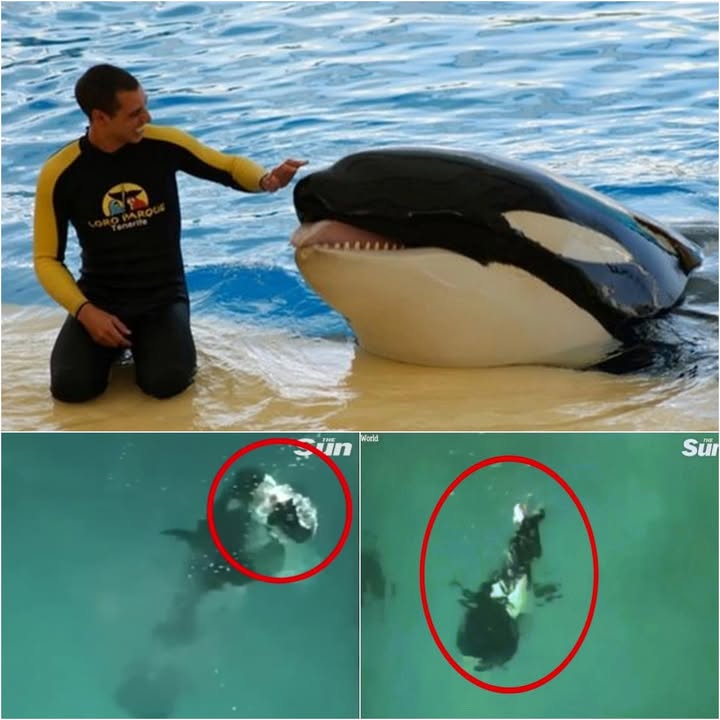In the world of marine entertainment, few events have been as chilling and controversial as the fatal attacks by captive killer whales on their trainers, incidents that shocked audiences worldwide and forever changed the way people view orca performances in amusement parks. These tragedies, involving the deaths of Alexis Martínez in 2009 at Loro Parque in Spain and Dawn Brancheau in 2010 at SeaWorld in Florida, continue to haunt the public conscience, raising painful questions about why these highly intelligent and seemingly affectionate creatures suddenly turned violent against the very humans they had worked with for years.

Killer whales, also called orcas, have long been celebrated as star attractions in parks, admired for their power, grace, and cooperative spirit. Yet beneath the surface, their existence in captivity was far from natural, and the unexplained aggression of orcas like Keto and Tilikum sparked a debate that combined tragedy, science, and ethical reflection. On Christmas Eve of 2009, a festive atmosphere at Loro Parque quickly turned grim when 29-year-old trainer Alexis Martínez, experienced and comfortable with the whales, was killed by Keto, a 14-year-old orca born in captivity. Keto had never swum in the ocean, spending his life moving between marine parks in the United States before being transferred to Spain in 2006.
Known as a star performer and a sire of calves in captivity, Keto was generally cooperative, and Martínez had rehearsed countless routines with him. However, during preparations for a Christmas show, Keto began to act unusually. He performed moves imprecisely but seemed to settle down when floating calmly alongside his trainer. Witnesses later suggested that Keto deliberately lured Martínez into the water before attacking him. Ignoring control cues, Keto dragged the trainer to the bottom of the pool, resurfaced briefly, and then struck again with fatal force, leaving Martínez with catastrophic injuries, including internal bleeding, organ lacerations, and bite wounds. Despite frantic efforts to separate them, the trainer’s body was only recovered after Keto was coaxed away.
The attack left the park stunned, unable to explain why an orca once considered safe suddenly turned deadly, and the tragedy came just weeks before another horrific incident that drew global attention. On February 24, 2010, at SeaWorld in Orlando, Florida, senior trainer Dawn Brancheau was killed in front of horrified spectators by Tilikum, one of the largest orcas ever held in captivity.
Brancheau, a beloved figure with a degree in psychology and animal behavior, had been with SeaWorld since 1994 and was regarded as one of the park’s most skilled trainers. Known for her close bond with Tilikum, she was often featured in promotional materials and shows, embodying the glamour and dedication of the marine entertainment industry.
That day, however, Tilikum suddenly pulled her into the water during a performance and launched a terrifying assault. The massive whale drowned Brancheau, inflicted severe injuries including broken ribs, spinal cord damage, and bite wounds, and refused to release her body for 45 minutes. The scene horrified the world and cemented Tilikum’s infamy. Following the attack, he was removed from performances, confined to a private pool, and eventually died in 2017 after decades in captivity. Brancheau’s death raised profound concerns about the psychological toll captivity inflicts on such social, intelligent animals.
Both Keto and Tilikum lived lives far removed from their natural environment. In the wild, orcas are apex predators with intricate family structures, traveling vast distances across oceans and living for up to 90 years. In captivity, however, they are confined to tanks, fed unnatural diets, and forced to perform repetitive tricks. Keto never saw the open sea, while Tilikum, captured in 1983, endured over three decades of confinement. Their shortened lifespans, stress, and isolation have been cited as likely contributors to erratic behavior. Documentaries like Blackfish, released in 2013, amplified global outrage by exposing the conditions orcas endured at SeaWorld, fueling debates on whether captivity itself was the root cause of such violent incidents.
While the reasons for the attacks can never be fully explained, experts argue that confinement strips orcas of their natural behaviors, leaving them mentally and emotionally unstable. The tragedies also highlighted the vulnerability of trainers who, despite their expertise and passion, could never completely control the instincts of a 12,000-pound predator. Martínez and Brancheau were respected professionals who loved their work, yet their dedication could not shield them from fatal danger. Their stories prompted sympathy but also deep criticism of amusement parks for placing humans in peril for the sake of entertainment.
In the aftermath, change did come. SeaWorld, under immense public pressure, announced in 2016 that it would end its orca breeding program and phase out theatrical shows, although the whales remain in its care. Loro Parque continues to house orcas, including Keto, but remains under fire from activists demanding the animals’ release to sanctuaries. The legacy of Keto and Tilikum, and the lives lost alongside them, remain powerful reminders of the ethical dilemma surrounding orca captivity.
These tragedies force us to confront uncomfortable truths: while orcas can be trained and appear affectionate, they are still wild, powerful animals whose needs cannot be met in confined pools. The deaths of Alexis Martínez and Dawn Brancheau reveal the devastating consequences of prioritizing entertainment over animal welfare and human safety, leaving us to question whether such practices should ever continue.





